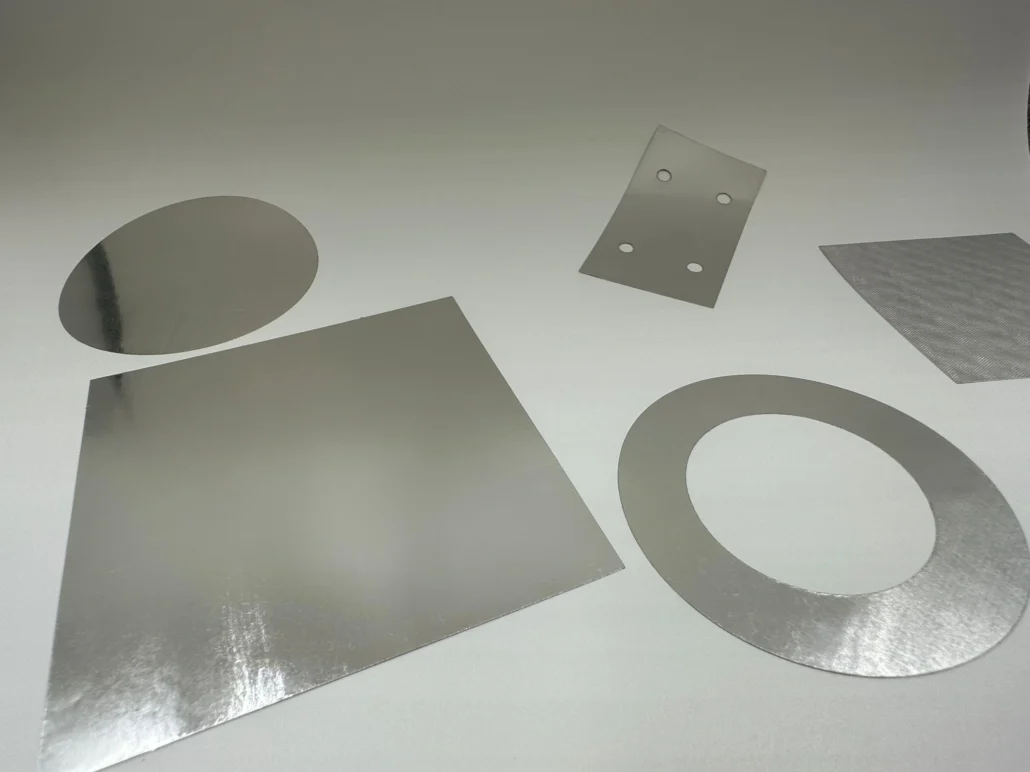인듐 진공 씰 헬륨 밀폐형 씰, 브리징 금속 및 유리 및 세라믹과 같은 비금속 기판을 만들기 위한 우수한 소재로 돋보입니다. 그 다용성은 극저온 환경, 진공 펌프 및 열에 민감한 영역으로 확장되어 안정적인 봉쇄를 보장합니다.
인듐이 실런트 역할을 할 때, 다른 개스킷 재료의 단순한 장벽 형성과는 달리 연결 표면과 화학적 결합을 시작합니다. 특히, 인듐 씰은 기계적 충격, 진동 및 극한 온도에 대한 복원력을 보여 까다로운 응용 분야에 없어서는 안 될 요소입니다.
인듐의 고유한 특성은 표면에 산화막을 형성하는 경향입니다. 기판과 깨끗한 결합을 형성하려면 이 필름이 압축 및 소성 변형을 통해 파괴되어야 합니다. 인듐의 전성에 의해 촉진되는 이 공정은 극저온에서도 쉽게 발생하여 효과적인 밀봉을 보장합니다.
품질 인듐 인감 여러 가지 요인에 따라 달라집니다.
- 순수함과 청결함: 일부 응용 분야에서는 99.999% 인듐 순도를 요구하지만 최적의 인듐 순도 수준인 99.99%가 선호됩니다. 오염물질, 특히 유기화합물은 탈지를 통해 제거해야 합니다. 표면 산화물은 50% 염산에 잠깐 담근 후 탈이온수로 헹구면 제거될 수 있습니다.
- 표면 준비: 모든 표면은 철저한 청소와 건조를 거쳐야 합니다. 유리 및 세라믹 표면은 크롬산과 황산으로 처리한 후 염산과 탈이온수로 헹궈야 합니다. 인듐 금속 표면은 노출되지 않거나 인듐으로 사전 주석 도금되거나 인듐 또는 은으로 도금될 수 있습니다. 표면 마무리는 과도한 연마나 연마 변형 없이 주의 깊게 수행되어야 합니다.
- 인듐의 두께와 모양: 인듐 씰의 두께는 표면적과 압축력에 따라 달라집니다. 인듐 'O' 링 홈 응용 분야에서 인듐 씰은 압축 시 홈 크기를 5-15% 초과해야 합니다. 인듐의 겹치는 부분은 특정 시나리오에서 연속 와셔를 대체할 수 있습니다. 잘 형성된 씰은 2 x 10-7 torr x 리터/초 미만의 누출률을 나타냅니다.
인듐 선택, 표면 준비 및 밀봉 구성에 대한 세심한 절차를 준수함으로써 엔지니어는 중요한 응용 분야에서 밀봉 밀봉의 신뢰성과 효율성을 보장할 수 있습니다.

물리적 특성
가장 주목할만한 물리적 특성 중 하나 인듐 뛰어난 연성과 연성입니다. 인듐은 모스 경도가 1.2에 불과하여 구리(2.5-3)와 알루미늄(2-2.9)보다 상당히 낮아 훨씬 부드럽고 변형하기 쉽습니다.
156.6°C의 비교적 낮은 녹는점을 가지고 있어, 특정 밀봉 용도에 맞게 프리폼이나 와이어 등 다양한 모양과 크기로 쉽게 성형할 수 있습니다.
인듐은 접합 표면과 필요한 압축력에 따라 얇은 두께(0.008인치)에서 두꺼운 두께(0.062인치)까지 제작될 수 있습니다.
화학적 특성
밀봉 특성
인듐열이 필요 없이 밀폐형 밀봉을 형성하는 능력은 열이나 납땜 플럭스로 인해 가스 발생과 같은 문제가 발생할 수 있는 환경에서 특히 유용합니다.
인듐을 실런트로 사용하면 연결하는 표면과 화학 결합이 시작되어, 단순히 장벽 역할을 하는 다른 개스킷 재료에 비해 뛰어난 밀봉 성능을 제공합니다.
이러한 특성으로 인해 인듐 씰은 기계적 충격, 진동 및 극한의 온도에서도 무결성을 유지하므로 까다로운 응용 분야에 없어서는 안 될 제품입니다.
표면 준비
적절한 표면 준비는 고품질 인듐 씰을 얻는 데 중요합니다. 표면은 철저히 세척하고 건조해야 하며, 다양한 재료에 대한 특정 처리가 필요합니다. 예를 들어, 유리 및 세라믹 표면은 크롬산과 황산으로 처리한 다음 염산과 탈이온수로 헹구어야 합니다.
인듐 금속 최적의 결합을 보장하기 위해 표면에 사전 주석 도금이나 인듐 또는 은 도금이 필요할 수 있습니다.
인듐의 가단성으로 인해 압축과 소성 변형을 통해 표면 산화물을 제거하는 것이 용이해져 극저온에서도 효과적인 밀봉이 보장됩니다.
인듐의 다재다능함은 헬륨 밀폐 밀봉을 형성하는 데 사용되어 금속과 유리 및 세라믹과 같은 비금속 기질을 연결할 수 있습니다. 이는 인듐을 진공 펌프, 극저온 환경 및 기타 열에 민감한 영역에서 안정적인 성능이 필요한 응용 분야에서 필수적인 소재로 만듭니다.
인듐 진공 밀봉 기술
인듐 진공 밀봉 기술 인듐의 고유한 특성을 활용하여 극저온 환경, 진공 펌프, 열에 민감한 구역을 포함한 다양한 응용 분야에서 안정적이고 효과적인 밀봉을 만듭니다.
이 기술은 특히 유리나 세라믹과 같은 금속 기질과 비금속 기질을 모두 연결하는 헬륨 밀폐 밀봉을 형성하는 능력으로 인해 높이 평가받고 있습니다.
속성 및 장점
인듐 낮은 녹는점, 높은 연성, 높은 연성이 특징이어서 진공 밀봉에 이상적인 재료입니다.
단순히 장벽을 형성하는 다른 재질의 개스킷과 달리 인듐은 연결하는 표면과 화학적 결합을 형성하여 기계적 충격, 진동 및 저온에 대한 씰의 회복력을 향상시킵니다.
인듐의 주목할 만한 특징은 표면에 산화막을 형성하는 경향이 있다는 것입니다. 기판과 완벽한 결합을 이루려면 이 산화막을 압축과 소성 변형을 통해 파괴해야 하는데, 이는 금속의 연성으로 인해 용이해지는 과정입니다.
이를 통해 열이 필요 없이 극저온에서도 효과적인 밀봉이 보장됩니다.
응용
인듐 진공 밀봉 독특한 특성과 극한 조건에서 효과적으로 작동할 수 있는 능력으로 인해 광범위한 응용 분야가 있습니다. 인듐 씰의 다재다능함은 항공우주 및 자동차부터 의료 및 산업 분야에 이르기까지 다양한 산업에 적합합니다.
항공우주 및 자동차
항공우주 및 자동차 분야에서 인듐 씰은 뛰어난 밀봉 특성과 고압 및 고온 조건에서 진공을 유지하는 능력으로 사용됩니다. 이를 통해 혹독한 환경에서 작동하는 구성 요소 및 시스템의 무결성이 보장됩니다.
의료 및 산업
인듐 진공 씰의 의료 및 산업적 응용 분야는 광범위합니다. 인듐 씰은 진단 도구 및 생체 임플란트와 같이 높은 순도와 신뢰성이 필요한 의료 기기 및 장비에 사용됩니다. 예를 들어, 개인화된 의학 및 진료 시점(POC) 진단은 종종 분자 수준에서 작동하는 장치에 의존하는데, 여기서 씰의 정확한 기능이 중요합니다.
스마트 기술 통합
증가하는 추세 인듐 씰 디자인 스마트 기술의 통합입니다. 사물 인터넷(IoT)의 확장으로 다양한 프로세스를 실시간으로 모니터링하고 제어할 수 있는 밀봉 솔루션에 대한 수요가 증가하고 있습니다. 인듐 씰은 고유한 특성으로 인해 이러한 응용 분야에 적합하여 광범위한 시나리오에서 사용할 수 있습니다. 인듐 씰에 센서 및 기타 스마트 장치를 통합함으로써 제조업체는 보다 효율적이고 지능적인 밀봉 솔루션을 만들 수 있습니다.
표면 분석 기술
초고진공(UHV) 응용 분야에서 인듐 씰은 표면 분석 기술에 필요한 진공 조건을 유지하는 데 중요합니다. 이러한 기술에는 X선 광전자 분광법(XPS), 오제 전자 분광법(AES), 2차 이온 질량 분석법(SIMS) 등이 있습니다. UHV 조건은 이러한 분석 중 표면 오염을 줄이는 데 필수적입니다. 인듐 씰은 이러한 고정밀 기술에 필요한 엄격한 진공 조건을 달성하는 데 도움이 되어 정확하고 신뢰할 수 있는 측정이 가능합니다.
떠오르는 기술
오염 방지 특성, 생체 임플란트, 진단 장치와 같은 새로운 기술도 이를 사용하여 이점을 얻습니다. 인듐 진공 밀봉. 이러한 응용 프로그램은 바이오인터페이스에 대한 기본적인 이해와 무균 및 오염 없는 환경을 유지하는 능력이 필요합니다. 인듐 씰은 현대 기술의 엄격한 요구 사항을 충족하는 신뢰할 수 있는 씰링 솔루션을 제공함으로써 이러한 분야에 크게 기여합니다.
요약
안 인듐 진공 씰 는 전성, 연성 및 밀폐 밀봉을 형성하는 능력으로 알려진 포스트 전이 금속인 인듐의 고유한 특성을 활용하는 특수 밀봉 기술입니다. 인듐 진공 밀봉은 연결하는 표면과 화학적으로 결합하여 헬륨 밀폐 밀폐 밀봉을 형성하는 능력으로 인해 높은 평가를 받고 있습니다. 이러한 화학적 결합은 단순히 장벽 역할을 하는 것이 아니라 기계적 충격, 진동 및 극한의 온도를 견뎌내는 뛰어난 밀봉 기능을 보장합니다.
